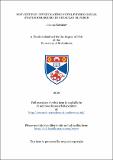Files in this item
Not just fat : investigating novel physiological state biomarkers in cetacean blubber
Item metadata
| dc.contributor.advisor | Hall, Ailsa J. | |
| dc.contributor.advisor | Miller, Patrick | |
| dc.contributor.author | Kershaw, Joanna | |
| dc.coverage.spatial | 200 p. | en_US |
| dc.date.accessioned | 2019-06-26T15:39:10Z | |
| dc.date.available | 2019-06-26T15:39:10Z | |
| dc.date.issued | 2019-06-26 | |
| dc.identifier.uri | https://hdl.handle.net/10023/17977 | |
| dc.description.abstract | Despite its importance as a predictor of fitness, no consensus has been reached about how to assess the nutritive body condition of free-ranging cetaceans. Standard indices of condition used in terrestrial ecology were assessed in cetaceans using data and samples from stranded animals. The most appropriate morphometric indices were identified as mass/length2 and girth/length (where mass data were unavailable). Blubber thickness, and blubber lipid content were poor indicators of condition. Variation in lipid content suggested that there may be tradeoffs occurring between different blubber functions involved in energy storage, controlling buoyancy, and preserving thermoregulatory properties in species with different life-history strategies. Novel blubber biomarkers of physiological state were investigated as objective and widely applicable tools for estimating body condition. Blubber cortisol concentrations were negatively correlated with morphometric indices of condition in stranded animals from two cetacean families. Blubber cortisol concentrations were thus identified as a candidate biomarker. When applied to a 13-year dataset of biopsy samples from female humpback whales (Megaptera novaeangliae), cortisol concentrations showed significant inter-annual variation. Concentrations were weakly correlated with annual pregnancy rates. High individual variability in blubber cortisol concentrations was likely a result of the multi-functional nature of cortisol. Cortisol concentrations thus probably provide a ‘snap shot’ of the metabolic state of the tissue when sampled. A proteomic approach was developed to extract and identify proteins in blubber. A range of proteins involved in numerous metabolic processes and pathways were identified. These proteins likely capture the range of physiological processes experienced by individuals at the time of sampling. This new proteomic approach will help to assign novel functions to marine mammal blubber in keeping with current understanding of the multi-functional role of adipose tissue as an endocrine organ in mammals. It will also allow the future development of protein biomarkers of health and physiological state. | en_US |
| dc.language.iso | en | en_US |
| dc.publisher | University of St Andrews | |
| dc.subject.lcc | QL737.C4K48 | |
| dc.subject.lcsh | Cetacea--Physiology | en |
| dc.subject.lcsh | Blubber--Composition | en |
| dc.subject.lcsh | Humpback whale--Pregnancy | en |
| dc.title | Not just fat : investigating novel physiological state biomarkers in cetacean blubber | en_US |
| dc.type | Thesis | en_US |
| dc.type.qualificationlevel | Doctoral | en_US |
| dc.type.qualificationname | PhD Doctor of Philosophy | en_US |
| dc.publisher.institution | The University of St Andrews | en_US |
| dc.identifier.doi | https://doi.org/10.17630/10023-17977 |
This item appears in the following Collection(s)
Items in the St Andrews Research Repository are protected by copyright, with all rights reserved, unless otherwise indicated.

